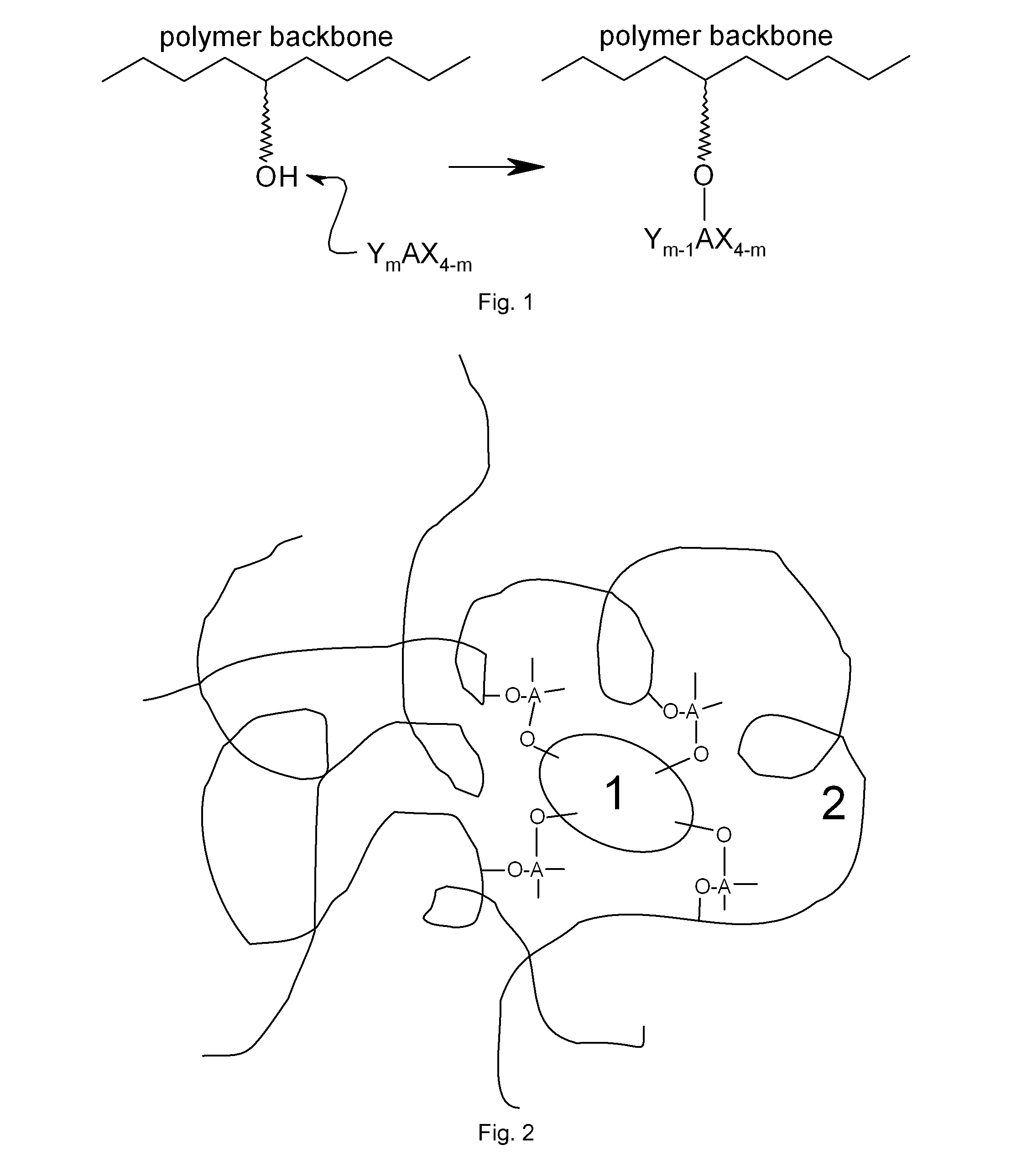Fluoropolymer-based hybrid organic/inorganic composites
a hybrid organic/inorganic composite and fluoropolymer technology, applied in the field of fluoropolymer-based hybrid organic/inorganic composites, can solve the problem that the proposed approach is not suitable for fluoropolymer
- Summary
- Abstract
- Description
- Claims
- Application Information
AI Technical Summary
Benefits of technology
Problems solved by technology
Method used
Image
Examples
example 9
Preparative Example 9
Step j) Manufacture of a E-CTFE-HPA Terpolymer
[0151]In an enameled autoclave equipped with baffles, and stirrer working at 450 rpm, 3 l of demineralized water, 52.5 g of chloroform, 35 ml of a solution of hydroxypropylacrilate(HPA) (40% volume) and water (60% volume) and 7 kg of chlorotrifluoroethylene were introduced. Then the temperature was brought to 15° C. and ethylene was fed up to a pressure of 8.2 absolute bars. In the autoclave the radical initiator was then continuously fed during the polymerization under a form of a solution, maintained at −17° C., of trichloroacetylperoxide (TCAP) in isooctane having a titre of 0.12 gTCAP / ml. Furthermore 35 ml of the solution of hydroxypropylacrylate and water were fed at consumption of 20, 40, 60, 80, 100, 120, 140, 160, and 180 g of ethylene.
[0152]The pressure was maintained constant during 345 min, by continuously feeding ethylene to the reactor up to a consumption of 200 g.
[0153]The product discharged from the au...
example 10
Comparative Preparative Example 10
Step k) Manufacture of a ECTFE Polymer
[0158]In an industrial reactor an ECTFE copolymer having approximately a molar composition of 43% E and / 57% CTFE was synthesized at a temperature of 15° C. and 7.2 absolute bar of pressure. The polymer obtained was found to have a melting point of 185° C., a MFI (220° C. / 2.16 Kg) of 1.4 g / 10 min and a solubility in NMP at 120° C. of 23% w / w.
Step kk) Manufacture of a Hybrid E-CTFE / Silica Composite
[0159]Same procedure as under step jj) of example 9 was followed, but using 10 g of the ECTFE copolymer from step k). A turbid and highly viscous solution was obtained.
Step kkk) Coating of a Glass Substrate with the Hybrid E-CTFE / Silica Composite
[0160]Same procedure as above described under step jjj) in example 9 was followed for attempting to prepare the coated glass plate, but using the solution obtained from step kk) herein above.
[0161]In these conditions, the solution partially solidified during casting, so than no ...
example 11
Preparative Example 11
Step I) Manufacture of the VDF-HEA Copolymer
[0162]Same copolymer as in example 1i) was used.
Step II) Manufacture of a Hybrid VDF-HEA / Silica / Clay Composite
[0163]A nano-dispersion of Laponite RD in water was obtained mixing 2.6 g of deionized water with 0.056 g of Laponite RD powder by sonication at room temperature for 90 min.
[0164]Laponite RD is a synthetic hectorite sold by LAPORTE company, having the following average agglomerated particle distribution: 0.7 percent 600 micron,[0165]7.3 percent in the range 500-250 micron,[0166]52.6 percent in the range 250-106 micron,[0167]39.4 percent 75 micron,[0168]and wherein lamellar elementary inorganic particles have an average thickness of about 1 nm and an average length of 50 nm measured by AFM (Atomic Force Microscopy).
[0169]The gel obtained was diluted by addition of 40 g of NMP and further sonication for 30 min at room temperature and 30 min at 60° C., until obtaining a clear and homogenous liquid composition.
[01...
PUM
| Property | Measurement | Unit |
|---|---|---|
| organic | aaaaa | aaaaa |
| solution | aaaaa | aaaaa |
| toughness | aaaaa | aaaaa |
Abstract
Description
Claims
Application Information
 Login to View More
Login to View More - Generate Ideas
- Intellectual Property
- Life Sciences
- Materials
- Tech Scout
- Unparalleled Data Quality
- Higher Quality Content
- 60% Fewer Hallucinations
Browse by: Latest US Patents, China's latest patents, Technical Efficacy Thesaurus, Application Domain, Technology Topic, Popular Technical Reports.
© 2025 PatSnap. All rights reserved.Legal|Privacy policy|Modern Slavery Act Transparency Statement|Sitemap|About US| Contact US: help@patsnap.com



